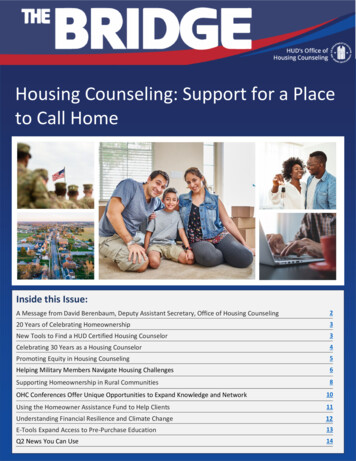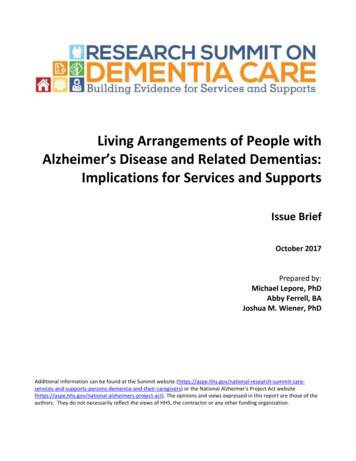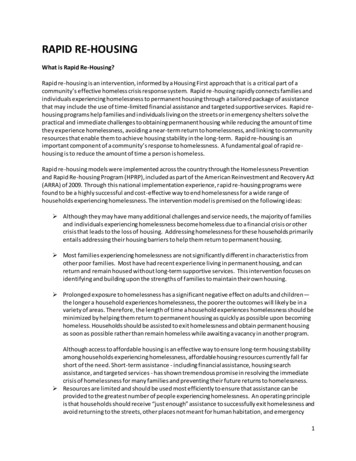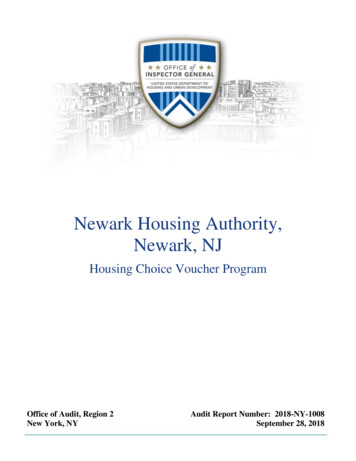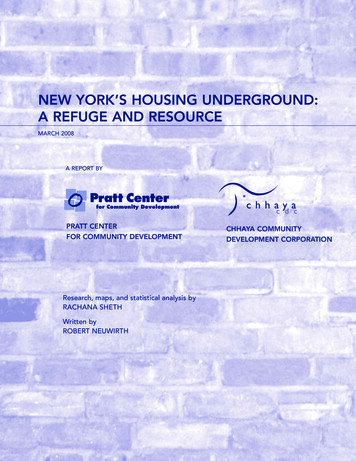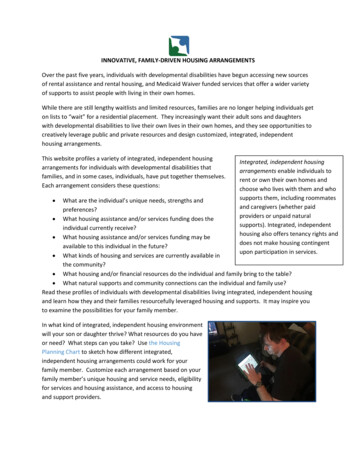
Transcription
INNOVATIVE, FAMILY-DRIVEN HOUSING ARRANGEMENTSOver the past five years, individuals with developmental disabilities have begun accessing new sourcesof rental assistance and rental housing, and Medicaid Waiver funded services that offer a wider varietyof supports to assist people with living in their own homes.While there are still lengthy waitlists and limited resources, families are no longer helping individuals geton lists to “wait” for a residential placement. They increasingly want their adult sons and daughterswith developmental disabilities to live their own lives in their own homes, and they see opportunities tocreatively leverage public and private resources and design customized, integrated, independenthousing arrangements.This website profiles a variety of integrated, independent housingarrangements for individuals with developmental disabilities thatfamilies, and in some cases, individuals, have put together themselves.Each arrangement considers these questions: Integrated, independent housingarrangements enable individuals torent or own their own homes andchoose who lives with them and whosupports them, including roommatesand caregivers (whether paidproviders or unpaid naturalsupports). Integrated, independenthousing also offers tenancy rights anddoes not make housing contingentupon participation in services.What are the individual’s unique needs, strengths andpreferences? What housing assistance and/or services funding does theindividual currently receive? What housing assistance and/or services funding may beavailable to this individual in the future? What kinds of housing and services are currently available inthe community? What housing and/or financial resources do the individual and family bring to the table? What natural supports and community connections can the individual and family use?Read these profiles of individuals with developmental disabilities living integrated, independent housingand learn how they and their families resourcefully leveraged housing and supports. It may inspire youto examine the possibilities for your family member.In what kind of integrated, independent housing environmentwill your son or daughter thrive? What resources do you haveor need? What steps can you take? Use the HousingPlanning Chart to sketch how different integrated,independent housing arrangements could work for yourfamily member. Customize each arrangement based on yourfamily member’s unique housing and service needs, eligibilityfor services and housing assistance, and access to housingand support providers.
Answering these questions will help you narrow the field of options. There may be several housingarrangements that would make your family member happy, healthy and safe, but if you cannot obtaincertain critical housing, service or financial resources, then it does not make sense to pursue thishousing arrangement. Likewise, the steps you take to put a housing arrangement in place must berealistic and achievable. Finally, if you are likely to encounter insurmountable challenges or there is noclear, practical path to sustainability, then look at other options.Regardless, putting ideas down on paper is a great way to begin organizing your thoughts anddeveloping a plan of action. Then, go back and look at the Helpful Links in each profile for moreinformation on various resources, tools and experts. Finally, consult your DBHDS Regional HousingSpecialist for assistance with learning about creative housing arrangements and navigating housingresources statewide.Agency Directed Supports and PERS in a Subsidized Apartment. Ron lives in anapartment property that has units with subsidized rents. He has a MedicaidDevelopmental Disabilities Family and Individual Supports Waiver which providespersonal assistance services and a Personal Emergency Response System. As he agesand his needs change, he will transition from drop-in to live-in personal assistanceservices. Please click the paragraph above if you want to read more about Ron'sjourney.Apartment with State Rental Assistance and Live-in Aide. Ryan is on the waitlist for theMedicaid Developmental Disabilities Waiver. He lives in a privately owned condominiumunit. The State Rental Assistance Program (SRAP) provides a subsidy to make the rentaffordable. Ryan needs someone to live with him to provide fellowship and monitor hissafety and well-being. He received a reasonable accommodation (an exception to theSRAP rules and policies) for a live-in aide and was approved for a subsidy for a twobedroom unit. The aide can live with him at no extra cost. Please click the paragraphabove if you want to read more about Ryan's journey.Consumer Directed Supports, Accessibility & Rent Assistance. Josh lives inan apartment made affordable with a Special Admissions Preference HousingChoice Voucher. A Medicaid Developmental Disabilities Individual and FamilySupports Waiver funded environmental modifications to make his home accessible.The waiver also pays for consumer-directed personal assistance, assistivetechnology, and a personal emergency response system that enable him to enjoy fulluse of his home. Please click the paragraph above if you want to read more aboutJosh's journey.Family Sublease with Resident Assistant. Sean is on the waitlist for a MedicaidDevelopmental Disabilities Waiver. He lives in a single family home with twofriends who also have disabilities and a resident assistant. Sean’s dad rents thehome from a private owner and then subleases to each of the residents. Theresident assistant’s rent is reduced in exchange for providing basic supports suchas chore reminders, encouragement to attend social activities, and social/emotional“check-ins.” Please click the paragraph above if you want to read more about Sean'sjourney.
Family Supported Personal Residence. Katelyn is on the waitlist for a MedicaidDevelopmental Disabilities Waiver. She lives in a condominium unit that her parents ownand rent to her. The State Rental Assistance Program (SRAP) provides a subsidy to makethe rent affordable. Katelyn needs someone to live with her to provide supports essentialto her care and well-being. She received a reasonable accommodation (an exception to theSRAP rules and policies) for a live-in aide and was approved for a subsidy for a two bedroomunit. The aide can live in the unit at no extra cost. Katelyn also uses personal assistanceservices funded by a CCC Waiver and locally funded self-directed services. Please click theparagraph above if you want to read more about Katelyn's journey.Sponsored Residential Services in Independent Housing. Rogan lives in an accessiblesingle family home with his caregiver, Rachel, and her family. Rogan and Rachel bothrent from Rogan’s parents, Mike and Patty, who purchased the home with alow interest mortgage and placed it in a Special Needs Trust. Rogan and Rachel eachhave a separate lease.Rogan has a Medicaid Developmental DisabilitiesCommunity Living Waiver which funds the sponsored residential services that Rachelprovides. Please click the paragraph above if you want to read more about Rogan'sjourney.KEY THEMES ACROSS INTEGRATED, INDEPENDENT HOUSING ARRANGEMENTSRegardless of the approach, individuals and families often shared some similar observations that areworth keeping in mind as you explore new approaches to creating integrated, independent housingarrangements:1. Start early. Preparing for integrated, independent housing takes a LOT of time and energy, andtransitioning from the family home to a new home of one’s own does not go smoothly when you are in“crisis mode.” Families who successfully transitioned their son or daughter with a disability emphasizethat they began planning the move when their child was 20-30 years old. The process often takesseveral years. This slow, methodical transition enables families to see how the new arrangementfunctions, to work the kinks out and to make realistic sustainability plans.2. Build a strong circle of support. Families with strong circles of support relied on these networks tohelp with many facets of the transition to integrated, independent housing. Some used their network tohelp find landlords, and others used it to help find caregivers or roommates. Still others accessed theirnetwork to help them navigate different systems, including their local public housing agency’s HousingChoice Voucher program or to obtain assistive technology and environmental modifications using aMedicaid Waiver for people with developmental disabilities. Some families involved relatives andfriends in stocking their loved one’s new home full of furniture and household supplies. Do not be shy:this is the time to let people know what you are trying to do and to rally their support for your family!3. Research the impact of transitioning to integrated, independent housing. When a young adult witha disability moves out of the family home, many government programs and private health care insurersno longer consider the individual a “disabled dependent.” Many families did not realize this, and theywere surprised by the impacts of this change in status: some negative and some positive. Before you
take any serious steps toward transitioning an individual out of the family home to their own housing,check into these issues: Health insurance. If the individual has private health insurance, ask whether the individual canretain coverage if he or she moves out of the family home. Some individuals who were coveredunder their parents’ policy as disabled dependents have lost private or military health insurancecoverage when they moved out because the health insurer no longer considered them“dependent.” Supplemental Security Income (SSI). An individual who receives SSI and lives with family doesnot receive the full SSI benefit if the family does not charge him rent. The monthly SSI benefit isreduced because the family is providing the individual “in-kind support and maintenance” forhousing. However, when the individual moves out and pays for housing on his own, theindividual may qualify for the full SSI benefit even if he receives rent assistance.Conversely, consider an individual who lives with her family and receives the full SSI benefit. Ifshe moves out and her family provides additional financial support to help her pay the monthlyrent for her new apartment, then the individual’s monthly SSI benefit could be reduced becauseher family is providing “in-kind support and maintenance” for housing. Rent subsidies such asHousing Choice Vouchers and the State Rental Assistance Program do not have an impact on SSIbenefits. Likewise, ABLE accounts can be used to help pay for housing without impacting SSIbenefits. Eligibility for other public benefits and programs. Once individuals establish their ownhouseholds separate and apart from their parents, they may qualify for public benefits such asSupplemental Nutritional Assistance Program (SNAP) or heating and cooling assistance throughthe Department of Social Services. They may also be eligible for Lifeline, which provides asubsidy for cellphone or Internet service. Restrictions on parents as live-in aides. Individuals who employ their parents as personal careattendants through Medicaid Waiver consumer-directed services and rely on them for 24/7 caremay encounter barriers to using certain types of rent assistance and employing a parent as alive-in aide. Some rent assistance programs such as the State Rental Assistance Program do notpermit applicants to live with parents, grandparents or guardians. Housing Choice Voucherprograms may not permit a pre-existing household member to be a live-in aide. If you havequestions about potential impacts, contact your DBHDS Regional Housing Specialist.4. Good caregivers are hard to find. Whether using an agency or directly hiring people to assistindividuals in their homes, it is difficult to find and retain knowledgeable, trustworthy, professionalcaregivers. Caregivers move from one job to another seeking better wages, benefits, hours, commutesand working conditions. If the caregiver’s services are funded by Medicaid, it may be hard to offer morecompetitive pay. For example, Medicaid has strict rules about not supplementing an attendant’s rate ofpay for hours worked in its consumer-directed Waiver services. Low wage rates make it hard to find and
retain attendants, especially in areas with a high cost of living. Families have found ways to makeworking conditions more attractive by reimbursing attendants for out of pocket expenses like gas,meals, or entry fees for recreation activities incurred on the job. Other families hire the same attendantprivately at a higher rate of pay for additional hours not covered by Medicaid consumer-directed waiverservices. Some families have helped individuals secure a reasonable accommodation for a live-in aidethrough rent assistance programs. They offer the attendant free rent in exchange for providing essentialcare and supports. The attendant is still paid for early morning or evening hours worked and can attendto the individual’s safety and well-being during sleeping hours in an emergency.5. Back up the back up. Parents have learned that naming themselves as Plan B is often not enough inintegrated, independent housing: they may be out of town, ill or unable to provide the needed care. Itis critical to have a more comprehensive game plan for who will “sub in” if the live-in aide or the visitingcaregiver cannot make it because of a weather emergency, illness, sick child, etc. It is also important toknow who can serve as a temporary replacement if caregiver turnover becomes an issue. If youcurrently use consumer-directed services, consider getting to know a few agencies that staff the sameservice and find out what their capacity is to ramp up supports. Also, get to know other families whohave individuals in integrated, independent housing in the community and consider forming a “back-upcooperative” with qualified people who are on call in case someone needs a caregiver to sub in.6. Be prepared for your role to change. Many parents found that their roles changed dramaticallywhen their adult child with a disability moved into integrated, independent housing. They were nolonger “primary caregivers”, but they had instead become “care coordinators.” The responsibilitiesinclude scheduling caregivers, ensuring they arrive on time, monitoring the quality of care, making surethey communicate with the next “shift” as needed, signing timesheets as needed, and enforcingemployment agreements. This role can be a difficult adjustment for parents. First, it takes time to helpthe individual to adjust to a new home and to help the caregivers become familiar with the individual’sunique needs, develop a good communication system, establish a routine schedule, and develop somebasic protocols. Second, parents sometimes expect caregivers to support individuals the same way theydid. One family member noted, “I had to stop assuming the way I prepare oatmeal for my daughter isthe ONLY way to make oatmeal!” Third, as individuals began to feel comfortable living in their ownplaces, they would sometimes say during the course of a visit to family, “I am ready to go to my housenow.” This was a bittersweet moment for many parents, who realized that their son or daughter with adisability had truly left the nest. They could now, in some ways, take the next step in their own lives.
HOUSING PLANNING CHARTName of Housing Arrangement:Will This Housing Arrangement Make My Son/Daughter Happy, Healthy andSafe?What Aspects of This Arrangement Work for Your Family Member?What Aspects of This Arrangement Would You Change?What Required Resources, Tools & Experts Do I/My Child Already Have for ThisHousing Arrangement?Service-Related ResourcesHousing-Related ResourcesExpertsOther ResourcesWhat Required Resources, Tools & Experts Do I/My Child Need to Get for ThisHousing Arrangement?Service-Related ResourcesHousing-Related ResourcesExpertsOther Resources
What Are the Steps We Must Take to Put This Housing Arrangement inPlace?1.2.3.4.5.6.7.8.9.10.What Challenges/Issues Are We Likely to Encounter?Challenges/Issues:How Will We Address These Challenges/Issues?What Steps Must We Take to Make This Housing Arrangement Sustainable?1.2.3.4.5.6.7.8.9.10.
Agency Directed Supports and PERS in aSubsidized ApartmentSUMMARY OF KEY ELEMENTSType of Housing: Privately managed RuralDevelopment (RD) 515 apartment propertyType of Services: Personal EmergencyResponse System (PERS) and PersonalAssistance ServicesMeet Ron:What Funds the Housing: project based rentsubsidy available in some RD 515 propertiesWhat Funds the Services: MedicaidDevelopmental Disabilities Family andIndividual Supports WaiverRon lived in a single family home with his parents until his dad passedaway. The old home was challenging for Ron’s mom to negotiate with hisaccessibility needs. Together they moved to a nearby apartment inWarrenton using a Housing Choice Voucher. The unit was fully accessible.After Ron's mom died, he stayed in the apartment because it felt like home.Without mom, managing consumer directed services becameoverwhelming, so Ron’s case manager helped him move to agency directedpersonal assistance services (PAS). Recently, the apartment propertystopped accepting vouchers and became a Rural Development 515property with rent-subsidized units. Ron’s rent contribution remained the same, but if he moves, hisrent amount could increase above what he can afford on his monthly Social Security payment. Ron hasalso made friends in the complex and has family nearby. These factors influenced his decision to stay.Ron’s case manager helped him access a Personal EmergencyResponse System (PERS) through the Medicaid Waiver. Thissystem permits Ron to push a button when he is alone, calls911 for him, and provides a profile including his name,location, and needs. PERS helps him feel safe: he has used itmany times for medical or other crises.Ron’s health needs are becoming more complex, so he is goingto have the PAS agency start providing a live-in aide for someovernight hours. Ron is open to other arrangements as heages, but his team wants to support Ron’s choice to stay where he is. As his needs change, his casemanager finds ways to get him what he needs.Ron attends a local day program that even offers him support for occasional evening events. Athome, he watches the Washington Redskins, reads books, watches game shows, and listens to hispolice scanner. Ron shares his thoughts through a Waiver-funded communication device. He saysthe best thing about his housing situation is, “I get to live independently and do the things I like todo. but that’s because I have the right people around me.”
The Process, Start to FinishHere are the steps Ron and his Team took to get his Agency Directed Services and PERS in an Apartment in place:1. Secure a support team of people who care about the needs of the person with a disability and trulywant them to be successful. The people on the team may change over time, which is fine. Ron found acase manager, friends and service providers who listen to what he wants and support him to achievehis goals.2. Identify the supports the individual will need to stay safe and independent in housing and follow therules of the lease, and scope out how these supports will be provided. Some supports may beprovided by family, friends and community members, or privately paid caregivers, but other servicesmay be funded by a Medicaid Developmental Disabilities (DD) Waiver or another Waiver. Apply forthe appropriate Medicaid Waiver(s) and develop an individual service plan.3. Apply for and use a Housing Choice Voucher to make rent affordable for someone on a fixed income ina high-cost housing market. Local Housing Choice Voucher programs have long waitlists which areoften closed. Ask the case manager to make a DBHDS Housing Referral for a Special AdmissionsPreference Housing Choice Voucher or other rental assistance resource.4. Also apply to rental housing that has project-based rent assistance, such as the Rural Development515 program. There may be a waitlist for this resource, too. While a person can be on multiplewaitlists, a person cannot accept a housing voucher and rent an apartment that has project-based rentassistance.5. Find an apartment near family that is fully accessible, so aging in place is possible.6. Line up caregivers in the home using Medicaid Developmental Disability (DD) Waiver funds byworking with the case manager. Personal Assistance Services (PAS) are available in the Medicaid DDWaivers for Family and Independent Supports and for Community Living.a. Determine if consumer- or agency-directed PAS are the best fit. People can use both consumerand agency-directed PAS, or move from one to the other like Ron did.b. Communicate closely with the PAS agency (if using one) on what the person needs and who isand is not a good fit for the position.7. Work with the case manager to secure the PERS system to allow for some monitoring and emergencysupport options for times when staff or family will not be present.8. Continuously work as a team and reevaluate support needs as people age or otherwise have morecomplicated needs. While a person’s needs may increase over time, respecting their wishes andallowing them the dignity of risk is critical for them to have a good life.Key Reasons for SuccessRon needed natural supports from his mom to initially find and secure the apartment and the Housing ChoiceVoucher. He still uses his brother- and sister -in law to help with financial management. Ron’s case managerhas been with him for many years and is very committed to helping him have the life he wants. The team atRon’s day support program has been with Ron for decades and work really hard to help him with things mostpeople rely on family to do, like assistance with medical appointments. Lastly, Ron and his team work closelywith his support agency to find the right personal care attendants and don’t settle for people who are not agood fit.Resources, Tools & Experts NeededHere are the resources, tools and experts Ron and his team assembled to make this approach work:Service-Related Resources
A Medicaid Developmental Disabilities Family and Individual Supports WaiverA licensed PAS provider agency to hire, train, pay and manage Ron’s personal care attendantsThe PERS monitoring and emergency system so Ron can quickly and easily get help if he has medicalconcerns or other crises ariseThe team at Ron’s day support program who helped him learn about and apply for the DD Waiver,which he received in 2001, and who support him with medical appointments and some after-hourseventsHousing-Related Resources A Housing Choice Voucher, which Ron and his mom initially used to move into his fully accessibleapartment Ron’s apartment converted to a Rural Development 515 property thatoffers him a project-based rent subsidy. These properties can havewaitlists – get on them months or a few years before you plan to move!Experts Ron’s brother and sister in law help with Social Security paperwork,visits, and advocating for Ron A dedicated case manager helps Ron through any challenges he hasOther Resources A communication device funded through the Waiver Transportation to and from his day program provided by the Countywhen Logisticare is too unreliableChallenges/Issues to Be Aware OfRon and his case manager readily acknowledge the biggest challenge is finding the right personal attendants.They have worked with a lot of people who were not the right fit for the job, but they stuck with it andcommunicated clearly with the agency. They did not settle for anyone who did not respect Ron’s choices.Starting to use a live in aide has helped with this.Ron’s health has declined significantly in the last decade, which makes it challenging to work and earn moremoney as he would like. So, Ron works carefully with his Representative Payee (his brother) on budgeting andfinding things he likes to do at low or no cost.Sustainability PlanRon is eligible to stay in his apartment as long as he wants with a project-based rent subsidy at this RuralDevelopment 515 property. As he has aged, he has moved from consumer directed to agency directedservices, added in PERS for emergency monitoring, uses a communication device more, and is starting to workwith a live-in aide. As long as Ron chooses to stay where he is, his team will continue leveraging the Waiverand other tools to ensure his success.Helpful LinksHousing Opportunities Made Equal of Virginia provides guidance for requesting reasonable accommodationsand modifications under the Fair Housing Act, including reasonable accommodations in housing for live-in
aides. See easonableAccomodations.pdfMedicaid Waivers are a funding source for long term, home and community based services and supportsfor people with developmental disabilities in Virginia. There are three waivers: Building Independence,Family & Individual Supports, and Community Living. Each funds a different constellation of services andsupports. See http://www.mylifemycommunityvirginia.org/Special Admissions Preference Housing Choice Vouchers is a rent subsidy for people with developmentaldisabilities in Virginia’s Settlement Agreement population. State and local public housing agencieschoose to participate and provide a preference in their Housing Choice Voucher and Public Housingprograms. ntal%20services/housing/set aside vouchers faq 3 2 16.pdf andthe DBHDS “My Own Home” Guidebook dds a home for me final 3 16 17.pdfPERS is a Waiver funded service that provides a push button alert system to contact emergency services withan updated profile of someone’s needs and risks. http://www.dmas.virginia.gov/Content pgs/ltc-wvr3.aspxRepresentative Payees are individuals or organizations appointed by the Social Security Administration toreceive the Social Security or Supplemental Security Income benefits for anyone who can’t manage ordirect the management of his or her benefits. A payee’s main duties are to use the benefits to pay for thecurrent and future needs of the beneficiary, and properly save any benefits not needed to meet currentneeds. A payee must also keep records of expenses and, upon request, provide accountings to SSA of howhe or she used or saved the benefits. See https://www.ssa.gov/payee/index.htmRural Development 515 Properties are multi-family apartment complexes financed by the U.S. Departmentof Agriculture. Properties are classified as Elderly or Family and provide unit sizes from studio to 4bedroom. The USDA also provides project-based rental assistance that is available in some of theseproperties. Tenants receiving rental assistance pay no more than 30% of their adjusted income for rent.Eligibility is determined by income standards set at the state and county level. To find RD properties incities and counties in Virginia, als/mfhcounties?st cd VA&fips 51&name VirginiaVirginia Housing Search is an on-line search tool for available, affordable rental housing in localitiesthroughout Virginia. The tool has specialized search functions that enable users to find rental housingwith accessibility features. See www.virginiahousingsearch.com.TAGS: accessible, assistive technology, Family and Individual Supports Waiver, housing choice voucher, MedicaidDevelopmental Disabilities Waivers, personal assistance services, personal emergency response system, projectbased rent subsidy, rental housing, rural developmentBack to the Main Page
Apartment with State Rental Assistanceand Live-In AideSUMMARY OF KEY ELEMENTSType of Housing: Condo owned by a privatelandlordType of Services: Live-in staff providesfellowship and monitors the person’s safetyand well-beingMeet Ryan:What Funds the Housing: Social Securityincome from individual and reduced rent fromState Rental Assistance Program (SRAP)What Funds the Services: A reasonableaccommodation allows a live-in aide to live in theunit at no cost as long as he/she provides essentialcare and supports to the person with a disabilityRyan lived at home with him mom and sister and attended a privatetherapeutic day school as a young teen. As his 18th birthdayapproached, Ryan became interested in moving to his own place.He felt ready to be an adult and have more grown up choices, so hismom helped him explore the options.Ryan’s mom had gone to housing presentations and read aboutoptions for Ryan for years, but never found quite the right thing.When she heard about the new State Rental Assistance Programavailable for people in the DOJ Settlement Agreement population, itsounded perfect, and it would be available when Ryan was turning18 and ready to move. She realized “I’m not always going to be here.It’s my job to get him set up with anything he can receive now.”Since Ryan was still in public school when he was planning to move, they needed to find a new homewithin the catchment area of his school, which narrowed the search considerably. The family workedwith their case manager and the DBHDS regional housing specialist and ultimately found a privatelandlord who owned a condominium property in Falls Church. The landlord had never heard of StateRental Assistance before, but he had an adult son with autism and was willing to learn more about theprogram. The landlord agreed to participate and the search for a live-in aide began. The first live-inaide was similar in age to Ryan, but ultimately was not a good fit. While he was able to be homeduring the necessary overnight hours, he could not offer the peer mentoring and other supports Ryanneeded to be successful. Ryan’s mom looked within her networks and found a Special Educationteac
arrangements that would make your family member happy, healthy and safe, but if you cannot obtain certain critical housing, service or financial resources, then it does not make sense to pursue this housing arrangement. Likewise, the steps you take to put a housing arrangement in place must be realistic and achievable.
